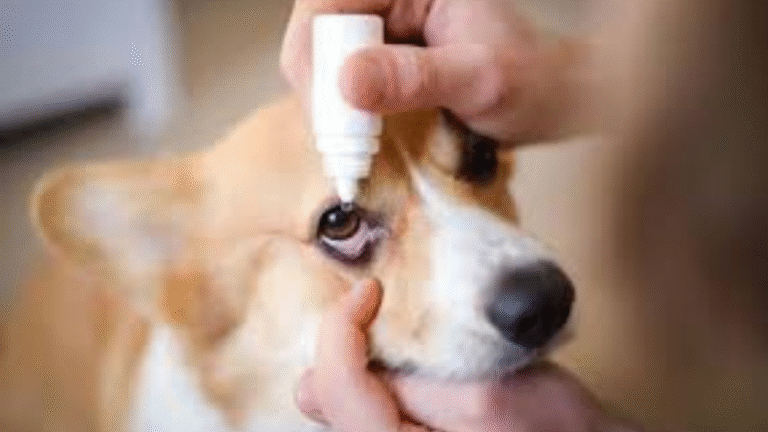Is your dog squinting, pawing at their eyes, or dealing with goopy discharge? It could be an eye infection—and your vet might prescribe ofloxacin eye drops for dogs as part of the treatment. Let’s break down what these drops are, how they work, and what you need to know to help your furry buddy heal up fast.
🔬 What Are Ofloxacin Eye Drops?
Ofloxacin is a broad-spectrum antibiotic that belongs to the fluoroquinolone family. It’s typically used in humans to treat bacterial infections of the eye—but it’s also frequently prescribed by vets for pets, especially dogs.
❓ Can Dogs Use Human Eye Drops Like Ofloxacin?
Great question! While you should never use any human meds on your dog without a vet’s approval, ofloxacin eye drops are an exception—when prescribed. Many vet-approved ophthalmic solutions are actually the same as those used for people, just with different labeling or dosage instructions.
👨⚕️ Why Vets Prescribe Ofloxacin for Dogs
So why do vets reach for ofloxacin when your dog’s eyes look irritated or infected? Let’s dig in.
Treating Bacterial Eye Infections
This is the big one. Ofloxacin is powerful against many strains of bacteria, making it ideal for bacterial conjunctivitis or keratitis.
Post-Surgical Eye Care
After eye surgery, like entropion correction or cherry eye removal, vets may prescribe ofloxacin eye drops for dogs to prevent post-op infections.
Corneal Ulcers or Abrasions
Injuries to the cornea can be painful and prone to infection. Ofloxacin helps prevent bacteria from making things worse while the eye heals.
🧪 How Ofloxacin Works in Canine Eyes
It stops bacteria in their tracks by interfering with their DNA replication. In short? It keeps the bad bugs from multiplying, which helps your dog’s eye heal faster and more comfortably.
👁 Common Dog Eye Problems Treated by Ofloxacin
Conjunctivitis
Pink, swollen eyes with discharge? That’s likely conjunctivitis—aka “pink eye.” If it’s caused by bacteria, ofloxacin is often the go-to.
Keratitis
This is inflammation of the cornea. It’s painful and can blur vision. Ofloxacin helps reduce the risk of secondary bacterial infections.
Blepharitis
When the eyelids themselves are inflamed or infected, these drops can help clear up the infection fast.
📏 Dosage: How Much Is Safe for Dogs?
The dosage depends on your dog’s weight, condition, and your vet’s specific instructions. That said, the most common guideline is:
-
1–2 drops per eye, 2–3 times daily, usually for 5 to 7 days.
⚠️Important: Never guess the dosage. Always follow the vet’s exact instructions to avoid under- or over-treatment.
💧 How to Properly Apply Eye Drops to Your Dog
Giving your dog eye drops sounds simple—until you’re dealing with a wiggly, uncooperative pup. Here’s how to make it easier:
Step-by-Step Guide
-
Wash your hands thoroughly.
-
Tilt your dog’s head upward while gently holding their chin.
-
Use your other hand to pull the lower eyelid down to create a “pocket.”
-
Drop the prescribed number of drops into the eye.
-
Let go, and reward with a treat or praise!
Tips for Wiggly or Nervous Dogs
-
Try swaddling smaller dogs in a towel like a “dog burrito.”
-
Have a helper gently hold your dog still.
-
Use calming treats or soft reassurance to keep them relaxed.
⚠️ Side Effects to Watch Out For
While most dogs tolerate ofloxacin well, side effects can occasionally happen. Keep an eye out for:
-
Redness or irritation getting worse
-
Excessive tearing or discharge
-
Squinting or pawing at the eye
-
Signs of an allergic reaction (swelling, difficulty breathing—call the vet immediately)
🛡️ Precautions and Safety Tips
-
Don’t touch the dropper tip to your dog’s eye—it can contaminate the bottle.
-
Finish the full course of medication, even if the eye looks better.
-
Store the drops at room temperature unless otherwise instructed.
⏰ What to Do If You Miss a Dose
Life happens! If you forget a dose:
-
Apply it as soon as you remember.
-
If it’s almost time for the next dose, skip the missed one—don’t double up.
🩺 When to See the Vet Again
If your dog’s symptoms:
-
Don’t improve after 2–3 days
-
Get worse
-
Return shortly after stopping the drops
…it’s time to head back to the vet for a follow-up.
🧪 Alternatives to Ofloxacin for Dogs
If your dog has a reaction or ofloxacin isn’t effective, your vet might try:
-
Tobramycin
-
Chloramphenicol
-
Gentamicin
-
Erythromycin
Each has its own pros and cons, depending on the infection.
✅ Final Thoughts
When it comes to treating eye infections in dogs, ofloxacin eye drops for dogs are a safe and effective option—but only when prescribed by your vet. They help clear up infections quickly, reduce discomfort, and prevent complications. Just follow the instructions, watch for side effects, and always finish the full treatment.
Your dog’s eyes will thank you—probably with a good tail wag!
❓FAQs About Ofloxacin Eye Drops for Dogs
1. Can I use leftover ofloxacin from my prescription for my dog?
Nope! Always get a fresh prescription. Dosing and formulation may differ, and it’s risky without a vet’s okay.
2. How long does it take ofloxacin to work in dogs?
Most dogs show improvement in 1–3 days, but full treatment usually lasts 5–7 days.
3. Can ofloxacin be used for viral or fungal eye infections in dogs?
No—ofloxacin only treats bacterial infections. Using it for viral or fungal infections won’t help and may cause issues.
4. What if my dog licks the eye drops?
A small amount likely won’t hurt, but try to keep them distracted afterward. If your dog ingests a lot, call your vet.
5. Are there natural alternatives to ofloxacin?
While there are some herbal rinses, they’re not as effective. Always consult your vet before trying any alternative treatment.

